 Angela Cutolo
Molto spesso le passioni, quelle che contraddistinguono il cammino personale di ciascuno, nascono grazie a insegnamenti o meglio alla capacità di un genitore di trasmettere la propria inclinazione verso qualcosa che non può non coinvolgere anche i figli; Angela Cutolo ha avuto il privilegio di avere un padre talmente appassionato di arte da portare lei e suo fratello fin da bambini in giro per mostre e musei, facendo nascere in lei il desiderio di essere a sua volta parte di quel magico mondo. Andare per le vie del centro di Roma in cui gli artisti esponevano le opere sui cavalletti, come accadeva due volte l’anno in via Margutta, le piaceva così tanto che decise di provare anche lei a dipingere, senza aver seguito un corso, senza avere una base accademica, ma con la determinazione di chi desidera dare sfogo a quella personalità sognatrice e quell’indole creativa che l’hanno accompagnata per tutta la adolescenza che trascorreva tra i quaderni su cui scriveva poesie e l’album su cui disegnava. Stranamente però la sua scelta scolastica fu completamente differente da quella che avrebbe immaginato poiché decise di iscriversi a Ragioneria, voleva trovare un lavoro stabile che le permettesse di mantenersi e di essere economicamente indipendente cosa che ottenne quando, poco dopo il diploma, fu assunta da Ferrovie dello Stato; tra il lavoro e la famiglia che aveva deciso di formare, il tempo da dedicare all’arte era sempre troppo poco anche se di quando in quando riusciva a sedersi davanti alla tela. Poi però, nove anni fa è andata in pensione e da quel momento in avanti si è sentita libera di riprendere la sua antica passione, mai dimenticata ma accantonata a causa della contingenza, ricominciando a effettuare un percorso di scoperta, di approfondimento della tecnica e anche dello stile pittorico che inizialmente era in costante evoluzione. Subito dopo aver ricominciato a dipingere infatti si è cimentata con scorci di paesaggi e ritratti di animali da compagnia che, nonostante avessero incontrato l’apprezzamento dei suoi collezionisti, non la soddisfacevano perché la sua naturale tendenza andava verso la narrazione della donna con tutte le sue sfaccettature; è stato così che ha cominciato a realizzare opere in cui il Realismo è solo il mezzo per tratteggiare le emozioni, le sensazioni che Angela Cutolo sente la necessità di immortalare mentre osserva le persone attorno a sé. Particolare fascino esercita su di lei il mondo del balletto, non solo quello classico che ha contraddistinto la produzione artistica di Edgar Degas ma anche quello più contemporaneo, hip hop, in cui l’energia del corpo si propaga all’intera tela e investe l’osservatore come se si trovasse in platea a teatro e osservasse ciò che accade sul palcoscenico. Nella tela Break Dance
Angela Cutolo
Molto spesso le passioni, quelle che contraddistinguono il cammino personale di ciascuno, nascono grazie a insegnamenti o meglio alla capacità di un genitore di trasmettere la propria inclinazione verso qualcosa che non può non coinvolgere anche i figli; Angela Cutolo ha avuto il privilegio di avere un padre talmente appassionato di arte da portare lei e suo fratello fin da bambini in giro per mostre e musei, facendo nascere in lei il desiderio di essere a sua volta parte di quel magico mondo. Andare per le vie del centro di Roma in cui gli artisti esponevano le opere sui cavalletti, come accadeva due volte l’anno in via Margutta, le piaceva così tanto che decise di provare anche lei a dipingere, senza aver seguito un corso, senza avere una base accademica, ma con la determinazione di chi desidera dare sfogo a quella personalità sognatrice e quell’indole creativa che l’hanno accompagnata per tutta la adolescenza che trascorreva tra i quaderni su cui scriveva poesie e l’album su cui disegnava. Stranamente però la sua scelta scolastica fu completamente differente da quella che avrebbe immaginato poiché decise di iscriversi a Ragioneria, voleva trovare un lavoro stabile che le permettesse di mantenersi e di essere economicamente indipendente cosa che ottenne quando, poco dopo il diploma, fu assunta da Ferrovie dello Stato; tra il lavoro e la famiglia che aveva deciso di formare, il tempo da dedicare all’arte era sempre troppo poco anche se di quando in quando riusciva a sedersi davanti alla tela. Poi però, nove anni fa è andata in pensione e da quel momento in avanti si è sentita libera di riprendere la sua antica passione, mai dimenticata ma accantonata a causa della contingenza, ricominciando a effettuare un percorso di scoperta, di approfondimento della tecnica e anche dello stile pittorico che inizialmente era in costante evoluzione. Subito dopo aver ricominciato a dipingere infatti si è cimentata con scorci di paesaggi e ritratti di animali da compagnia che, nonostante avessero incontrato l’apprezzamento dei suoi collezionisti, non la soddisfacevano perché la sua naturale tendenza andava verso la narrazione della donna con tutte le sue sfaccettature; è stato così che ha cominciato a realizzare opere in cui il Realismo è solo il mezzo per tratteggiare le emozioni, le sensazioni che Angela Cutolo sente la necessità di immortalare mentre osserva le persone attorno a sé. Particolare fascino esercita su di lei il mondo del balletto, non solo quello classico che ha contraddistinto la produzione artistica di Edgar Degas ma anche quello più contemporaneo, hip hop, in cui l’energia del corpo si propaga all’intera tela e investe l’osservatore come se si trovasse in platea a teatro e osservasse ciò che accade sul palcoscenico. Nella tela Break Dance
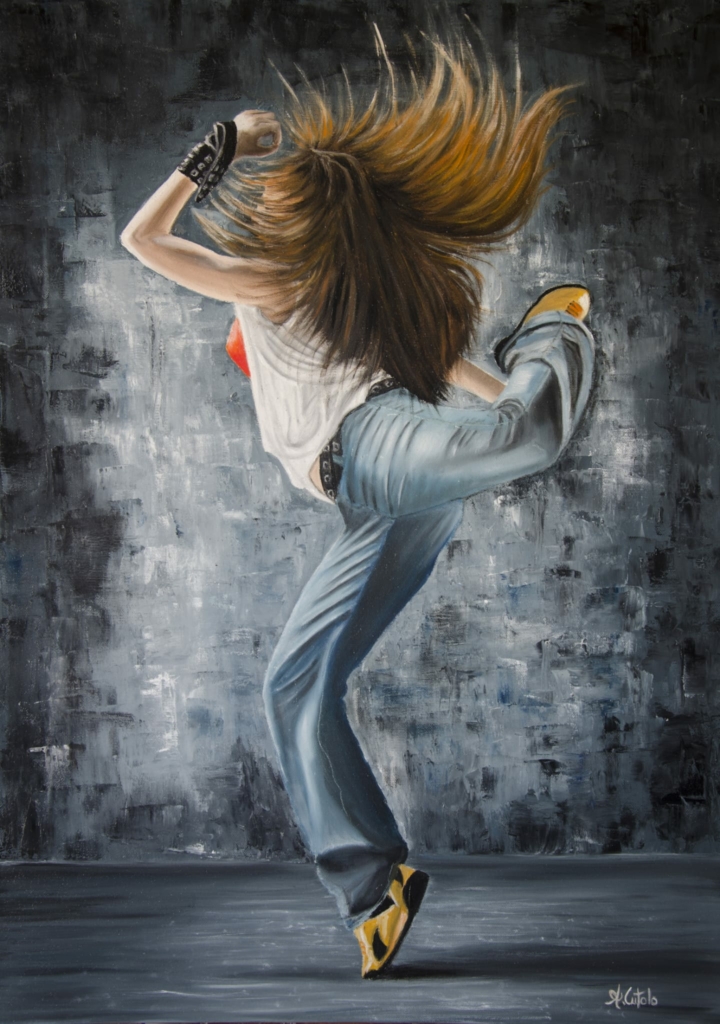
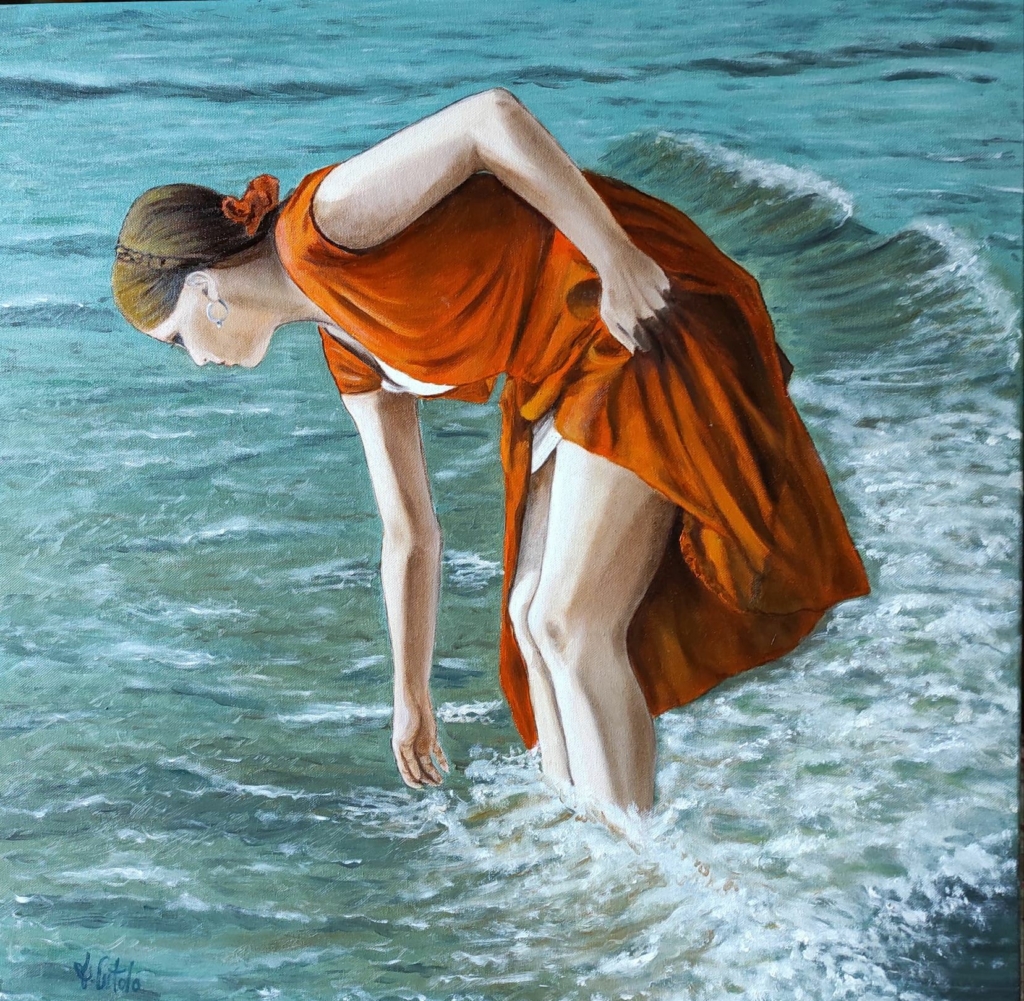
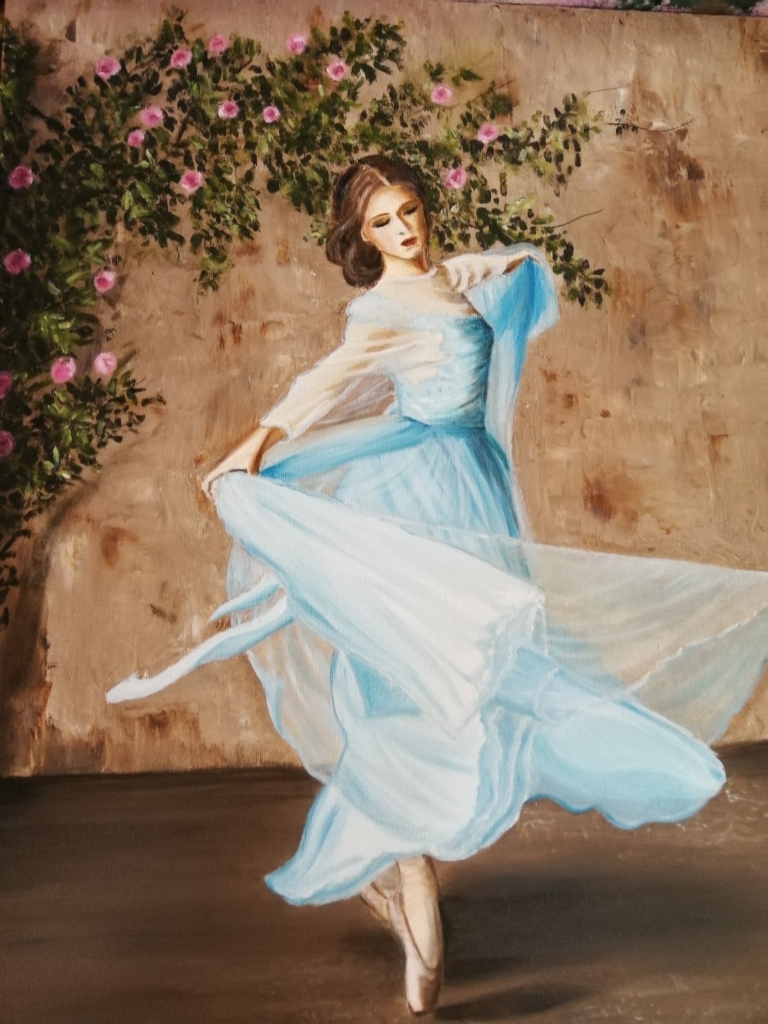
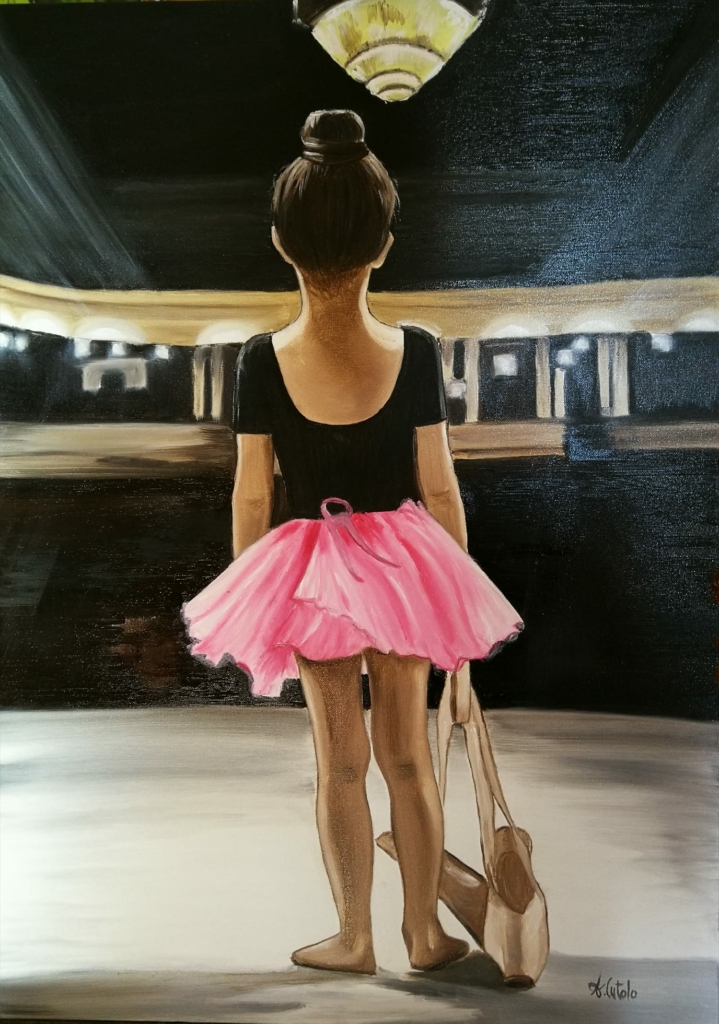
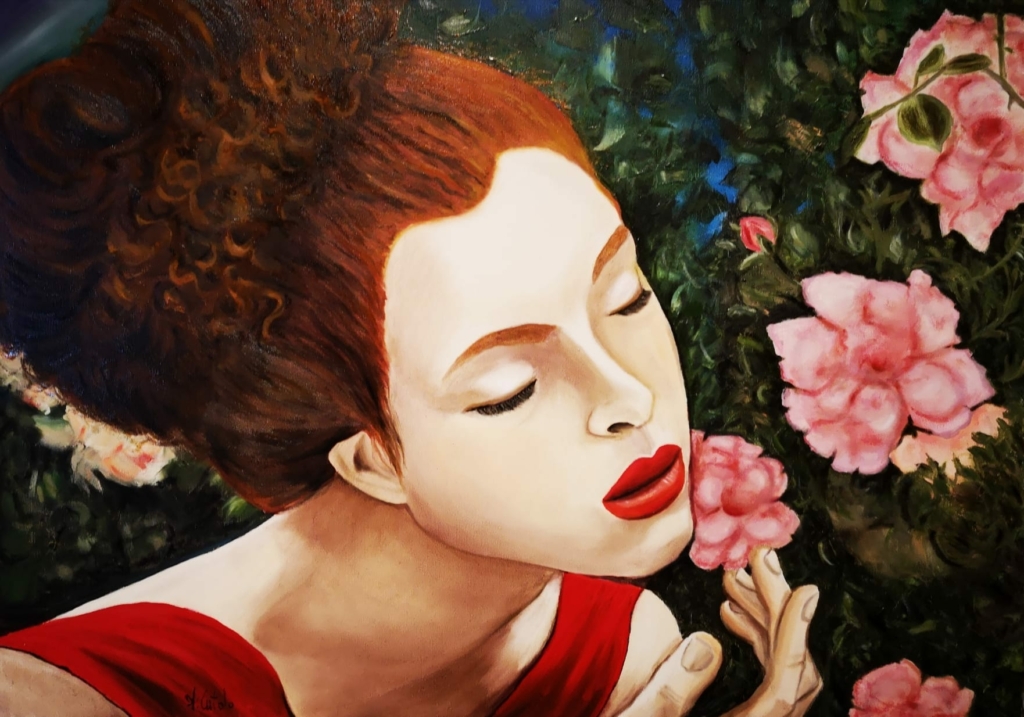
Marta Lock’s interviews:
Angela Cutolo, walking along via Margutta with her father dreaming to become a painter
Angela Cutolo had the privilege of having a father who was so passionate about art that he took her and her brother on visiting exhibitions and museums from an early age, giving her the desire to be part of that magical world. She liked going to the streets in the centre of Rome where artists exhibited their artworks on easels, as happened twice a year in Via Margutta, so much that she decided to try painting herself, without having followed a course, without having an academic background, but with the determination of someone who wants to give vent to that dreamy personality and creative nature that accompanied her throughout her adolescence, which she spent between the notebooks where she wrote poems and the album in which she drew. Strangely however, her choice of school was completely different from what she would have imagined, since she decided to enrol in accountancy, she wanted to find a stable job that would allow her to support herself and to be economically independent, which she obtained when, shortly after graduating, she was hired by Ferrovie dello Stato; between work and the family she had decided to form, the time she could dedicate to art was always too little, even if from time to time she managed to sit down in front of the canvas. But then, nine years ago, she retired and from that moment on, she felt free to resume her old passion, never forgotten but set aside due to the contingency, starting again to make a path of discovery, to deepen the technique and also the pictorial style that was initially in constant evolution. Immediately after she started painting again, in fact, she tried her hand at landscape views and portraits of pets which, although they had met with the appreciation of her collectors, did not satisfy her because her natural tendency was to narrate the woman with all her facets; it was thus that she began to produce artworks in which Realism is only the means of outlining the emotions, the feelings that Angela Cutolo feels the need to immortalise while observing the people around her. She is particularly fascinated by the world of ballet, not only the classical one that distinguished the artistic production of Edgar Degas, but also the more contemporary, hip hop one, in which the energy of the body spreads to the entire canvas and invests the observer as if he were in the theatre audience observing what is happening on the stage. In the canvas Break Dance, the artist succeeds in capturing the moment in which expressive intensity merges with the pose of the dancer’s body, conveying the idea of movement but also of strength, of the disruptive energy needed to take the leap and prepare for the next move. But it is not only the ballet that fascinates Cutolo rather the woman with her delicacy, her capacity for reflection and internalisation of experience, her vanity but also her naturalness, her unconscious charm as much as her sought-after and ostentatious charm, because in those many facets she finds herself, her empathy, her ability to intuit and interpret the expression of a face, a gesture, a distracted pose from which emerges the poetry that distinguishes the female essence. This is what the painting Il dolce sollievo del mare (The Sweet Relief of the Sea) is about, about letting oneself be transported by an emotional world in connection with the surrounding environment, about knowing how to savour the present moment by simply listening to one’s inner self, following the natural instinct through which one realises that at times all one needs to do is take a breath, detach oneself from contingency and be alone with oneself, without meditating, without having to think continuously, but just living in the moment. Let us now get to know the artist better through this interview. Angela, you had a very special bond with your father, who is also the person who gave you the love for art; can you tell us how much it counted seeing and knowing the artworks of the great masters of the past to stimulate in you the desire to be an artist in your turn? What did you feel when you went from being a spectator to becoming an artist, a guest at the exhibitions of the Cento Pittori di via Margutta? Being aware of the beauty of art from a very young age counted for a lot, and it was thanks to the discovery of the artworks of the great artists of the past, some of which I had seen in real life, others only on photographs in my father’s books, that my passion for painting was born. And it is also thanks to reading their sometimes extraordinary biographies that I too wanted to be part of that world. When I found myself in front of a masterpiece of the past, I carefully observed the drawing, the stroke of the brush, the lights, the shadows and above all the mastery in representing the faces, the eyes, the lips and the drapery of the clothes. The skill in making fabrics real: silks, brocades, velvets. And as I watched, my mind worked on how I too could make what I saw. The first time I participated in an exhibition of the Cento Pittori di Via Margutta was in June 2018 in Frascati. For me it was magic, really the realization of a dream in which I was the protagonist and not just a spectator and I would have loved that my father was still alive to be able to see him and be proud of me. In December of the same year I exhibited with them in the historic Via Margutta. It rained and it was cold for all four days of the event, but I didn’t notice anything, happy as I was to be there. Meeting so many artists, sharing experiences, their advice, and just chatting and laughing is something I will always remember. You have a particular predilection for the world of ballet, where did this passion come from? Who inspired you to tell this magical artistic universe, albeit of a different art from painting? Dancing is another of the arts that has accompanied me and in some way marked my life. Two people have played an important role in it: my aunt Marica, my father’s sister, who was a soloist in the corps de ballet at the San Carlo Theatre in Naples, and my grandfather Gastone, also a painter, who mainly painted scenes of ballets and dancers inspired by his daughter. When we would go with my father to Naples to visit them, I would never miss an evening at the San Carlo Theatre with my grandfather to see my aunt. Since then, I have loved attending classical dance performances and more. In fact I love all kinds of dancing. Right after you retired, you started painting full-time, how did this transition come about? Was the return to painting concomitant or did you have to face an inner journey that only later led you to the canvas? Long before I retired, I was already anticipating in my mind all the time I would finally have to devote to painting, so I was putting aside photographs and newspaper clippings from which I could draw inspiration for my future painting protagonists. When I finally retired, I started painting a wide variety of subjects: dogs, cats, landscapes, still lifes, in a sort of training and making up for lost time. Only after a year or so, not being satisfied, did I first question the technique, moving from acrylic to oil, and then the subjects, starting to paint only those that actually fascinated me. This is how the dancers and the portraits of women came about. You trained as a self-taught painter, but this did not prevent you from obtaining a very intense and realistic expressive technique; which masters of the past have inspired you or whom do you love more than others? Although I love all art, I have always been most moved by the impressionist painters, especially Edgard Degas. Among my favourite artists are also Dante Gabriele Rossetti, Edward Hopper and Giovanni Boldini. You often exhibit as a guest with the Cento Pittori di via Margutta, when will it be possible to see your artworks again? What projects do you have in the pipeline? I don’t know when I will exhibit with the Cento Pittori again, hopefully soon. This period of pandemic has taken me, like everyone else, away from exhibitions, but slowly new projects are restarting. For now, I am planning to exhibit on 19 and 20 March 2022 at the Artists’ Pavilion in the Conca d’Oro Market and from 7 to 9 April I will be at the fourth edition of the group exhibition Benvenuta Primavera (Welcome Spring), organised by the Associazione il Foro under the porticos of Via Ettore Franceschini in Rome, where last year I won the First Prize voted by the public with my painting Danza di Primavera (Dance of Spring).